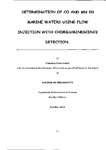DETERMINATION OF CO AND MN IN MARINE WATERS USING FLOW INJECTION WITH CHEMILUMINESCENCE DETECTION
| dc.contributor.author | Cannizzaro, Vincenzo | |
| dc.contributor.other | Faculty of Science and Engineering | en_US |
| dc.date.accessioned | 2013-11-21T14:34:21Z | |
| dc.date.available | 2013-11-21T14:34:21Z | |
| dc.date.issued | 2001 | |
| dc.identifier | NOT AVAILABLE | en_US |
| dc.identifier.uri | http://hdl.handle.net/10026.1/2815 | |
| dc.description.abstract |
This thesis describes the design, optimisation and shipboard deployment of a flow injection - chemiluminescence (FI-CL) technique for the determination of cobalt (Co) and manganese (Mn) in seawater. Chapter One presents an overview of the marine environment and the biogeochemistry of Co and Mn. Current analytical methods for the determination of Co and Mn in natural waters are also reviewed. Chapter Two reports reagent clean-up techniques and the synthesis of an 8- hydroxyquinoline resin used for in-line matrix elimination and preconcentration. The resin is also characterised in terms of its chelating ability for the transition metals and the earth alkaline metals. A new column design is also presented. Chapter Three details the optimisation of a FI-CL system for the determination of Co in seawater. The method described is based on a new chemistry whereby CL emission is produced by oxidation of pyrogallol with hydrogen peroxide in alkaline medium in the presence of CTAB and MeOH. Chapter Four details the optimisation of a FI-CL system for the determination of Mn in seawater. The method chosen involved the luminous oxidation of 7,7,8,8- tetracyanoquinodimethane (TCNQ) by dissolved O2. The weak chemiluminescence of TCNQ is effectively sensitised by Eosin Y in DDAB. In Chapter Five the application of the FI-CL method to the shipboard determination of Co in the western North Sea is presented together with results from the determination of Mn in the western North Sea samples after the cruise. Co and Mn profiles are shown for all the geographical area investigated. The data from an entire tidal cycle of the Humber are also shown. Chapter Six presents the results of an intercomparison exercise. Co and Mn have been measured with different analytical techniques: FI-CL, AdCSV, and ICP-MS. The method developed for Co has been adapted in order to measure the concentration of Co in samples from the Scheldt estuary with an integrated luminometer at the Universite Libre de Bruxelles. | en_US |
| dc.language.iso | en | en_US |
| dc.publisher | University of Plymouth | en_US |
| dc.title | DETERMINATION OF CO AND MN IN MARINE WATERS USING FLOW INJECTION WITH CHEMILUMINESCENCE DETECTION | en_US |
| dc.type | Thesis | |
| plymouth.version | Full version | en_US |
| dc.identifier.doi | http://dx.doi.org/10.24382/4319 |
Files in this item
This item appears in the following Collection(s)
-
01 Research Theses Main Collection
Research Theses Main


